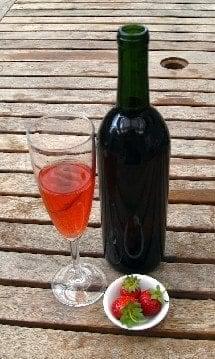Strawberry Melomel, also known as Strawberry Mead or Strawberry Wine, is one of my absolute favorite summer fermentations. Use the freshest, ripest strawberries you can find. I love to head to the u-pick farms in early- to mid-June for my early batches and again late in the season because in my opinion one can never have enough Strawberry Melomel.
Strawberry melomel is best about two years after bottling. I usually let mine stand a good six to nine months, racking three or four times during that period, before bottling. Once bottled, I store them on their side in a cool place where they’ll get a minimum of sunlight and temperature fluctuation. I serve my strawberry melomels at roughly room temperature for the fall, spring, and winter. In summer, room temperature is a little to warm for my taste, so I usually chill it in the refrigerator or freezer briefly before uncorking and serving.
This recipe is the simplest version of the many I’ve tried. It depends on good quality honey and fresh, ripe strawberries for its wonderful flavor. I have the good fortune of knowing a local beekeeper, who sells me raw, filtered honey in forty-pound buckets at a reasonable price. Before I’d made that wonderful connection, I substituted half the honey in this recipe for raw, unrefined sugar to keep my costs down. I called those batches Strawberry wine, and they were every bit as tasty as the Strawberry melomel I so love. The biggest difference was in the mouth feel; Melomels made with only honey and no other sugars tend to have more body than wines made in part with sugar.
The optional ingredients I’ve listed are all available through a variety of home brewing supply shops and sites.
Ingredients
- 1 gallon filtered water
- 2-1/4 pounds light honey
- 4 pounds fresh, cleaned, stemmed strawberries
- 1 tsp. yeast nutrient (optional)
- 1 campden tablet (optional)
- 1/2 tsp. pectic enzyme
- 1 packet Montrachet yeast
Equipment
- a plastic fermenter with a cover large enough to hold at least two gallons
- a bung and airlock
- a fine mesh bag large enough to hold all your fruit and be properly secured
- bleach or another sanitizing solution
- 1 mixing spoon
- measuring spoons
- a small measuring cup or another bowl for activating the yeast
- a gallon-sized glass jug with a well-sealing cover or bung and airlock and a racking tube (to be used after the primary fermentation)
- 5 bottles, corks, and corking equipment (to be used later for bottling)
Procedure
- Clean and stem your strawberries.
- Sanitize all of the equipment that will come in contact with your must. This includes your fermenter and its lid, airlocks and bungs, the fine mesh bag, and your mixing spoons.
- Measure one pound of honey into your sanitized fermenter.
- Add half a gallon or so of warm to cool filtered water.
- Use your mixing spoon (or your hands) to mix the honey and water until the honey is thoroughly dissolved in the water, thus creating the first half of your must.
- Add the other half gallon of water to your must in the fermenter.
- Carefully add the strawberries to the fine mesh bag and tie the top securely so that no bits of strawberry will escape as the must ferments.
- Add the bag of strawberries to your must.
- Use your hands (my favorite method) or a sanitized potato masher to carefully and thoroughly mash the strawberries. Your must will begin to blush with the juices released through this process. It’s a beautiful sight to behold.
- Add the yeast nutrient and the crushed campden tablet to the must. (If you are not going to add a campden tablet, you can add the pectic enzyme now and skip steps 12 and 13.) Mix well.
- Cover the fermenter with its lid, airlock, and bung.
- Let the must stand at room temperature for about 12 hours or so. I usually let mine stand until the next day.
- Add the pectic enzyme, mixing well and covering the must securely when you’re done.
- Let the must stand another 24 hours at room temperature.
- Pitch the yeast into your must using the procedure suggested by the manufacturer. If your yeast didn’t come with instructions, use the same method you would use for activating bread yeast, giving it about 10 minutes or so to activate before you pitch it into your must.
- Now the fermenting begins. Take a few moments each day to stir your fermentation, admire the wonderful work those little yeasties are doing, and anticipate the day when you’ll first imbibe its goodness.
Removing the Fruit, Racking, and Bottling

After you notice all signs of fermentation have ceased. (The airlock no longer dances or bubbles. The scent of the yeast at work has subsided.) Take a reading with a hydrometer or give it a taste. If the P. A. reads under 4 percent or you taste little to no sweetness in the brew, you’re ready to rack.
Rack, or transfer using a sanitized racking tube or siphon hose, your Strawberry melomel into a sanitized gallon-sized glass jug. Be sure to fill the jug to nearly the top, leaving only an inch or two maximum of space between the cap and the top of the melomel. (Air contact at this point can cause the melomel to have off-flavors or, horrifingly, to vinegarize.)
Let it stand in a safe, dark place for at least six months or until it has cleared completely. You will want to rack it several times through this period to help it clear and to prevent off-flavors.
When your melomel is crystal clear, or you’ve had enough of waiting, rack it into clean, sanitized bottles. Cork and label each bottle, then set them aside to mellow for at least a year, preferably two.
I prefer my wines dry, and Strawberry melomel is no exception. If you like a bit of sweetness in your wine, you can add wine stabilizer (available through home brewing supply sources) following the manufacturer’s instructions and then add a bit of raw, unrefined sugar or honey to your melomel just before bottling. A little bit of sweetener here goes a long way, so be sure to add just a small amount of sweetener at a time, mix thoroughly, then taste to determine just how much you need to satisfy your palate. Also, do not add sugar or honey to your wine before bottling it if you have not added an appropriate amount of stabilizer to your brew. Without stabilizer, fermentation will begin anew, resulting in carbonated or gushing wine or, worse, exploding wine bottles.
One gallon of wine or mead will fill approximately 5 standard-sized (750 ml) wine bottles.
Storage and Use
Store bottled Strawberry Melomel in a cool, dark place. When it’s young, it tends to be sharp, so let it age for a year or two. The Aging process will mellow your Strawberry Melomel into a treasure you’ll want to share…or perhaps hoard and enjoy all by you’re lonesome once you realize you’ve only a few bottles left to enjoy.
For more recipes and information on Strawberry including updated text; Standard and Advanced Medicinal Processing; Conditions best helped by Strawberry; Gardening and Gathering tips; Household uses; Animal Husbandry tips; Cautions; a Printable Quick Facts Page; and References, buy Strawberry: A Wealth of Healing in One Sweet Tasty Package on Amazon, volume 1 of our The Practical Herbalist’s Herbal Folio series.






